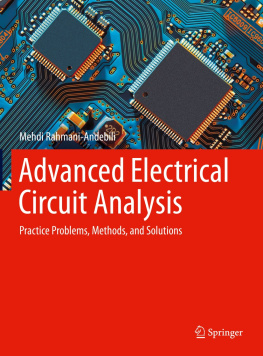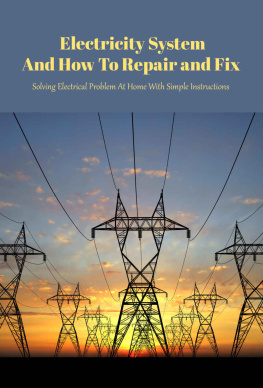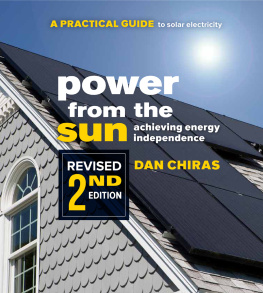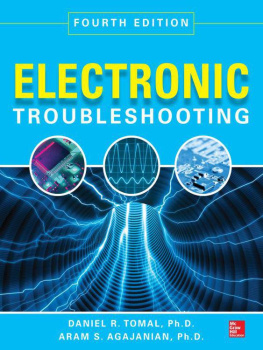For RVers who remain mystified by their RVs electrical systems120-volt alternating current (AC) and 12-volt direct current (DC)this book is a godsend. It provides a better understanding of what electricity is and what it does.
This problem-solving reference answers questions such as: Why do interior lights dim or burn out rapidly? and, Why wont the batteries recharge after a night without electricity? It tells you how to repair and improve electrical systems; how to troubleshoot faulty brakes, taillights, and house circuits; how to detect dangerous shorts, faulty grounds, inadequate connections, malfunctioning switches, dead battery cells, or current leakage; and much more.
This book could save your vacation, or even your life.

Ragged Mountain Press
Camden, Maine


Copyright 1995 by Bill and Jan Moeller. All rights reserved. Except as permitted under the United States Copyright Act of 1976, no part of this publication may be reproduced or distributed in any form or by any means, or stored in a database or retrieval system, without the prior written permission of the publisher.
ISBN: 978-0-07-182996-0
MHID: 0-07-182996-2
The material in this eBook also appears in the print version of this title: ISBN: 978-0-07-042778-5, MHID: 0-07-042778-X.
All trademarks are trademarks of their respective owners. Rather than put a trademark symbol after every occurrence of a trademarked name, we use names in an editorial fashion only, and to the benefit of the trademark owner, with no intention of infringement of the trademark. Where such designations appear in this book, they have been printed with initial caps.
McGraw-Hill Education eBooks are available at special quantity discounts to use as premiums and sales promotions, or for use in corporate training programs. To contact a representative please e-mail us at bulksales@mcgraw-hill.com.
The authors and publishers shall not be liable to any reader/user of this book for any indirect, incidental, or consequential damage, loss, or injury allegedly caused, in whole or in part, by relying on information in this book. Neither shall the authors and publishers be held responsible or liable for the use or performance of any manufacturers product, the suitability of any product for a particular purpose, or the use of any materials or methods described in this book.
It is the reader/users responsibility to exercise good and prudent judgment and to take any necessary and proper precautions when using the methods and products described herein.
TERMS OF USE
This is a copyrighted work and McGraw-Hill Education and its licensors reserve all rights in and to the work. Use of this work is subject to these terms. Except as permitted under the Copyright Act of 1976 and the right to store and retrieve one copy of the work, you may not decompile, disassemble, reverse engineer, reproduce, modify, create derivative works based upon, transmit, distribute, disseminate, sell, publish or sublicense the work or any part of it without McGraw-Hill Educations prior consent. You may use the work for your own noncommercial and personal use; any other use of the work is strictly prohibited. Your right to use the work may be terminated if you fail to comply with these terms.
THE WORK IS PROVIDED AS IS. McGRAW-HILL EDUCATION AND ITS LICENSORS MAKE NO GUARANTEES OR WARRANTIES AS TO THE ACCURACY, ADEQUACY OR COMPLETENESS OF OR RESULTS TO BE OBTAINED FROM USING THE WORK, INCLUDING ANY INFORMATION THAT CAN BE ACCESSED THROUGH THE WORK VIA HYPERLINK OR OTHERWISE, AND EXPRESSLY DISCLAIM ANY WARRANTY, EXPRESS OR IMPLIED, INCLUDING BUT NOT LIMITED TO IMPLIED WARRANTIES OF MERCHANTABILITY OR FITNESS FOR A PARTICULAR PURPOSE. McGraw-Hill Education and its licensors do not warrant or guarantee that the functions contained in the work will meet your requirements or that its operation will be uninterrupted or error free. Neither McGraw-Hill Education nor its licensors shall be liable to you or anyone else for any inaccuracy, error or omission, regardless of cause, in the work or for any damages resulting therefrom. McGraw-Hill Education has no responsibility for the content of any information accessed through the work. Under no circumstances shall McGraw-Hill Education and/or its licensors be liable for any indirect, incidental, special, punitive, consequential or similar damages that result from the use of or inability to use the work, even if any of them has been advised of the possibility of such damages. This limitation of liability shall apply to any claim or cause whatsoever whether such claim or cause arises in contract, tort or otherwise.
CONTENTS
Preface
Electricity in residences is taken for granted because it is always there, except for the rare power outage, and accessing it requires nothing more than flicking a switch or plugging in an electrical appliance. In an RV, however, electricity is not quite so straightforward. RVers themselves are responsible for bringing electrical power to the RV, which they do when they plug into a campgrounds electrical hookup. Additionally, there are two electrical systems to deal with: the familiar, 120-volt alternating current (AC), the type supplied to residences; and the often not so familiar 12-volt direct current (DC) supplied by the RVs batteries.
How these systems operate and interact is a mystery to many RVers; it is for them that this book is written. It provides a better understanding of what electricity is and what it does. It contains information that helps solve electrical problems that sometimes occur: why interior lights dim or burn out too rapidly, why batteries wont charge properly after a night without an electrical hookup, why there is no power, why batteries die sooner than expected, why there isnt adequate voltage at a campsite. The book explains how to make repairs to both systems, what tools and equipment are needed, and how to improve and upgrade RV electrical systems.
It will be obvious to those with a knowledge of electricity that the more esoteric aspects of the subjectcolumbs, joules, inductive and capacitive reactance, to name a feware omitted, and that we do not delve too deeply or at all into certain theorems and laws. Anything left out, however, in our opinion, is not necessary to a basic understanding of RV electrical systems. The book also does not discuss automotive electrical systems unless such systems directly relate to the RVs electrical functions. Ignition systems are not discussed because their function is relevant only to the vehicles engine operation; alternators are discussed because they are relevant to charging the RV batteries.
Our aim has been to keep this book as simple as possible while still enabling readers to thoroughly understand what constitutes RV electrical systems, how they work, and what to do when they dont. We have arranged the material so that, once read, the book can be used as a reference.
acknowledgments
So many people have given of their time and knowledge to help us in the preparation of this book; we couldnt have done the job without them.
We deeply appreciate the assistance of David Smead of Ample Power Company, and David Diamond of Country Coach, Inc., and we apologize for the numerous occasions we interrupted the work of these two busy gentlemen with our queries.
Noel Kirkby of RV Solar Electric, Neil Fridley of Cruising Equipment Company (CECO), and Keith Mann of MagneTek offered invaluable constructive criticism after reading sizable portions of the text.
Next page










